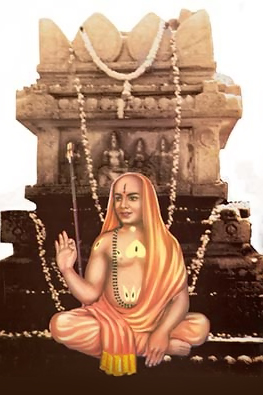Narahari Tirtha Pranam Mantra:
Sasita mulramarcca koshe Gajpateh Sthita,
Yenanita Namastsmai Srimannrihari Bhikshave
No specific information is available about the appearance of Narahari Tirtha. However, the time of his appearance is assumed to be around 1250 AD. His birthplace was somewhere in contemporary Utkala province. He was one of the chief disciples of Madhavacharya. Here are some miraculous events that happened in his life:
Some interesting insights into the divine life of Narahari Tirtha:
A few glimpses of the divine life of Narahari Tirtha are available in the vernacular literature of Orissa and Simhachala Pradesh. It is described there that he was a politician and a skilled warrior. He possessed many extraordinary qualities. Along with his administrative duties, he was engaged in the propagation of Vaishnavism. He converted many kings and nobles of Orissa and Andhra Pradesh into Vaishnavism.
An erudite scholar and versatile genius:
Narahari Tirtha was an erudite scholar in Sanskrit and Dvaita-Vedanta. He was also a renowned poet in the Kannada language. He composed many Kannada songs, poems, and Sanskrit hymns. All these writings are very simple, easy to understand, and contain the teachings of Madhvacharya. While writing all these, he used his former name ‘Raghupati’. He commented on the Brahma sutra bhasya of Madhvacharya. He also wrote a separate commentary on the Bhagavad Gita.
Ascending the throne of Kalinga:
Narahari Tirtha was a minister of Kalinga State in Odisha. He served the royal court for almost thirty years. When he was working in the royal court, the King of Kalinga died. The King’s son was very young. At that time, there was a practice in Kalinga that the ministers would appoint royal elephants for the election of the representative of the king in the absence of a suitable king or prince. The elephant would choose a particular royal servant and offer a garland around his neck. Everyone would accept him as the king of the kingdom. As usual, the elephant came out of the palace. However this time, it went through the road and reached to Narahari. Finally, the elephant put the garland around his neck. Everyone surprised. Since then, he has become the king of Kalinga.
Obtaining the service of “Moola Rama”:
Narahari Tirtha ruled the Kalinga kingdom for a long time. Then, when the prince grew up, he entrusted the kingdom to him. Out of gratitude, the newly-appointed king expressed a desire to reward him. Narahari Tirtha requested the king to get him the deity of “Moola Rama” formerly worshipped by the descendants of the Gajapati kings.
Ancient history of the “Moola Rama”:
This “Moola Rama” was worshiped by King Iksvaku of the Surya dynasty long before. Later, this deity was served by Dasharatha, the father of Lord Sri Ramachandra. Then, Lakshmana used to serve this deity. From him, Sri Hanumanji received this deity. Shri Hanumanji always kept this deity hanging around his neck. Later, in Dwapara Yuga, Shri Hanumanji handed over this deity to Bhima. Bhima gave this to Gajapati Maharaja. During Kavindra Tirtha, this deity was placed in Uttaradi Math. At present, this deity is being served in Raghavendra Tirtha Swami Matha on a daily basis.
Obtaining the deity of four-handed Kaliyadamana Krishna”:
Madhavacharya gave the “Chaturbhuja Kaliyadamana Krishna” deity to Srimannihari Tirthawhich depicts Krishna standing on the head of the Kaliya serpent with one leg raised in a dancing posture. One of his hands is balancing while dancing, and the other is holding Kaliya’s tail aloft. The deity is not like Vrindavanchandra or Vrajendranandana Krishna, but like Lord Narayana holding conch and chakra in the other two hands.
Lord Shri Vishnu in a dream:
Narahari Tirtha once went on a pilgrimage. At that time, when he was staying in a town near Hospet taluk in the Bellary district of North Karnataka. One day, he dreamt of a beautiful deity of Lord Vishnu in the pond of the town. The next day, he irrigated the pond and discovered a Narayan deity there. The deity was installed in the monastery. Since then, the city has been named ‘Narayan Deva Kiri’.
Books authored by Narahari Tirtha:
Narahari Tirtha wrote about fifteen books, but these books are now very rare. Only his commentary on Srimad Bhagavadgita and Bhavaprakashika survived.














